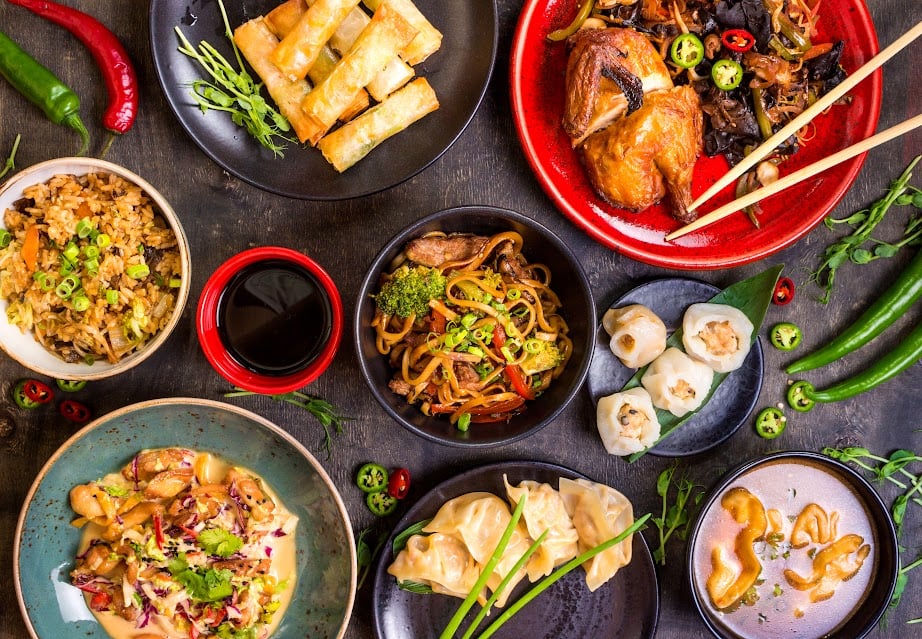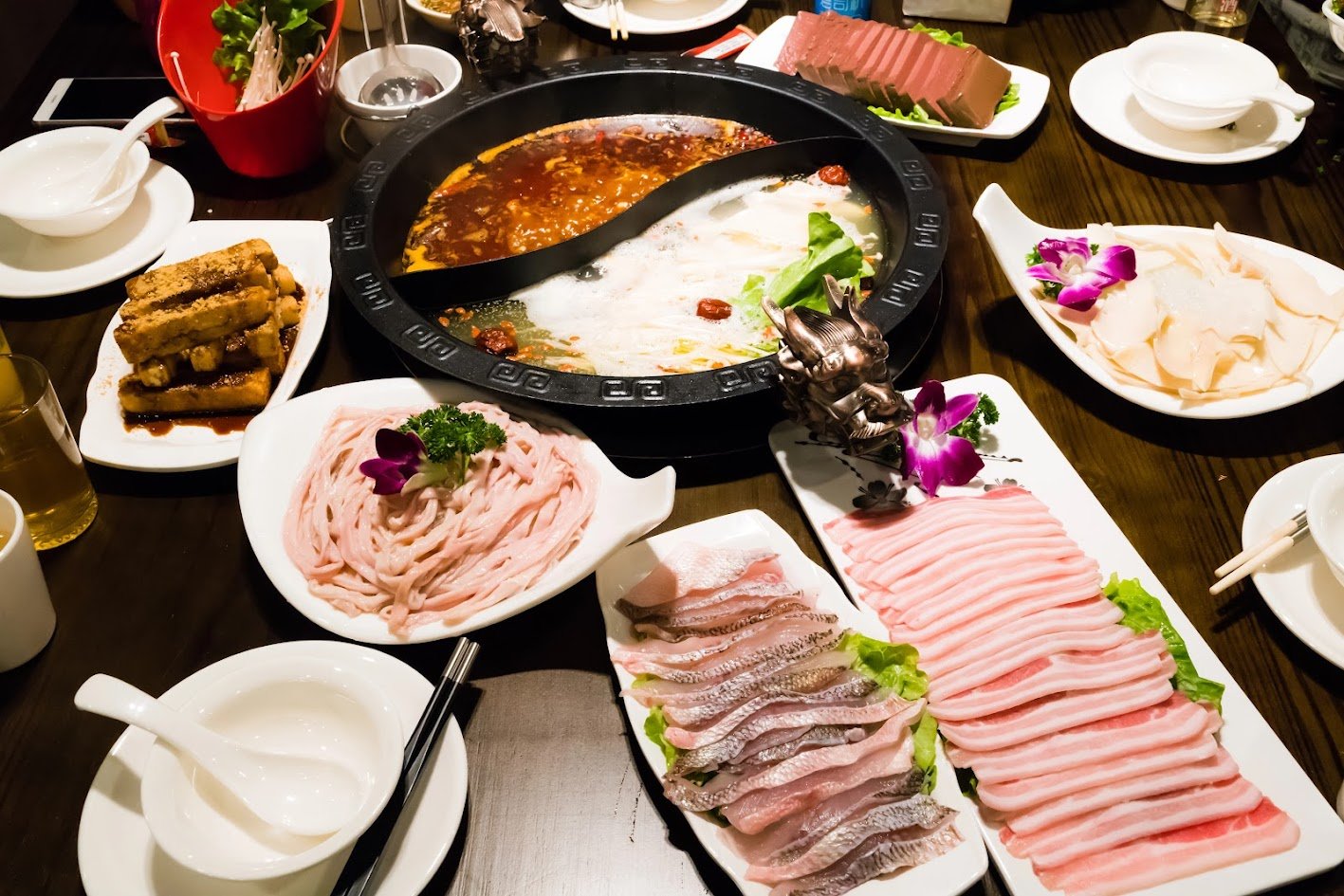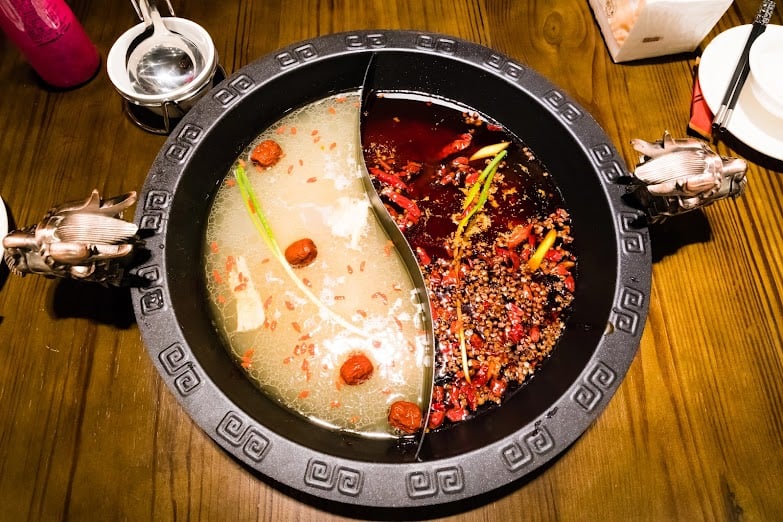Each region, ethnicity and historical period has its own culinary schools, creating a colorful picture of Chinese cuisine.
If you have the opportunity to visit the land of a billion people and want to experience Chinese cuisine, you should definitely not miss the opportunity to enjoy the special dishes of the 8 unique Truong Quoc culinary schools below:
1. Shandong cuisine:
1.1 Characteristics of Shandong cuisine, China
Shandong is a coastal province in the east of China, downstream of the Yellow River, with a terrain that is mainly plains but not lacking in majestic mountains. Shandong cuisine is known for its dishes with the rich and strong flavors of two indispensable ingredients: onions and garlic. Shandong people are strong in fried, grilled and steamed dishes. In addition, sophistication and refinement are emphasized in the preparation and decoration of dishes.
1.2 Special dishes of Shandong cuisine
- Dezhou Stewed Chicken : This dish's main ingredient is chicken stewed with honey, sugar and other ingredients for many hours before being served. The chicken is stewed until cooked but still retains its original shape. The meat is soft and can be easily separated from the bone, making diners remember it forever after eating it once.
- Sweet and sour carp : Not only is it a famous traditional Chinese dish, sweet and sour carp is also a local specialty in Shandong province. The main ingredient of this dish is fresh carp caught from the Yellow River or Huai River. Not only does it impress with its crispy texture on the outside and soft inside with a sweet and sour taste, this dish also makes diners admire the shape of the fish that resembles a blooming lotus flower.
- Stir-fried sea cucumber with onions : This is a typical nutritious dish of Shandong and a treasure in royal cuisine. To make the dish delicious and not have the strong fishy smell of ginseng, the chef must pay top priority to cleaning the sea cucumber as well as seasoning it properly.
2. Sichuan cuisine:
2.1 Characteristics of Sichuan cuisine, China
Sichuan has a very diverse and rich cuisine. In addition, Sichuan is also known as a mountainous region with a humid climate. Dishes with lots of chili and spicy spices not only help to prevent humidity and cold for the body but also help to enhance the flavor of the dish, remove the smell of some foods such as fish and meat. Sichuan pepper is one of the important ingredients of the cuisine here, with its own distinct aroma and strong flavor.
2.2 Special dishes of Sichuan cuisine
- Mapo Tofu : Famous for its spicy chili flavor, smooth tofu texture and rich flavor, Mapo Tofu is often prepared with ingredients such as fermented bean paste, pepper and other Sichuan spices.
- Sichuan Hot Pot : The main ingredients to make the hot pot broth include bones, Sichuan pepper, Sichuan chili, vinegar,... and some spices such as cinnamon bark, cardamom, fennel seeds, cloves, lemongrass. Sichuan hot pot is usually divided into two compartments: spicy and non-spicy, suitable for all diners. When eating, you just need to dip different ingredients such as birds, animals, mountain delicacies and seafood, meats, vegetables and tofu... into the broth and enjoy.
- Dan Dan Noodles: This dish is made with ingredients such as minced pork or beef, tofu, chili, pepper and chili oil, with some versions adding mushrooms or vegetables. The chewy, crispy noodles eaten with the rich, hot broth will make diners unforgettable.
3. Cantonese cuisine:
3.1 Characteristics of Cantonese cuisine, China
Guangdong is known for having more than 20 different ways of preparing dishes, but every dish must ensure 4 elements: aroma, color, taste, and shape. The dishes here are meticulously prepared, with high aesthetics from color, decoration to flavor, creating a diverse and rich culinary picture.
3.2 Special dishes of Cantonese cuisine
- Stuffed mackerel : One of the famous dishes in Guangdong, stuffed mackerel is prepared very delicately and elaborately. The sauce base is fish bone broth. Meanwhile, the stuffing is made from mackerel, Chinese sausage and mushrooms minced together, mixed with spices to taste.
- Cantonese Roast Duck: The duck is marinated with many spices such as tangerine peel, garlic, licorice powder, soybeans, wine and white vinegar for 2 hours before roasting. After roasting, the skin will become golden brown and very crispy. However, the body is still tender and sweet and not dry.
- Shunde-style braised chicken fillet : After being prepared, the chicken will be marinated with white wine, ginger, salt, rock sugar and rice flour for many hours to absorb the spices. This light dish is often eaten with white rice in daily meals.
4. Fujian cuisine:
4.1 Characteristics of Fujian cuisine, China
Fujian Chinese cuisine is famous for its skillful cooking techniques. Most dishes focus on umami flavor and the balance of sweet, sour and salty flavors. Visitors to Fujian Chinese cuisine will discover a unique Chinese culinary culture with irresistible seafood and soups.
4.2 Special dishes of Cantonese cuisine
- Buddha Jumps Over the Wall : This is a dish that symbolizes Fujian, consisting of 28 ingredients. The main ingredients are abalone, sea cucumber, shark fin, ham, mushrooms, etc. After marinating, put all the ingredients in a porcelain pot, add Shaoxing wine and boil for 10 hours.
- Fish ball soup: This dish uses deboned fish meat to shape into bite-sized balls, while the fish bones are used to simmer the broth. This dish is very suitable to eat with hot pot.
- Fujian Fried Noodles : The noodles are made from eggs and have an extremely eye-catching golden yellow color. The stir-fried ingredients are also varied, such as bean sprouts, chives, broccoli, and bell peppers. The thick sauce made from oyster sauce helps the fried noodles taste even richer.
Each region has many rich and diverse dishes, imbued with the culture and characteristics of the Chinese region.
5. Jiangsu cuisine:
5.1 Characteristics of Jiangsu cuisine, China
Jiangsu is famous for its mild, crispy and fresh dishes, especially fried, stewed and braised dishes. Jiangsu dishes are meticulously prepared, with high aesthetics from color, decoration to flavor, creating a diverse and rich culinary picture.
5.2 Special dishes of Cantonese cuisine
- Nanjing Salted Duck: This dish is famous for its ivory-white skin, soft meat, and fatty but not greasy meat. Around mid-autumn, when the magnolia flowers are in full bloom, that is the ideal time to make salted duck.
- Binh Kieu Tofu : This dish is quite simple to prepare. You just need to use chicken broth to cook with ingredients including crucian carp brain, pork fat, onions, etc. Then add thinly sliced tofu and diced meat to enjoy.
- Yangzhou Fried Rice : The ingredients of fried rice are quite rich. The rice used for this fried rice dish must be fluffy, smooth, not broken, not sticky. Besides, there must be carrots, bean sprouts, celery, tofu, beans, eggs and some types of meat such as shrimp and chicken.
6. Zhejiang cuisine:
6.1 Characteristics of Zhejiang cuisine, China
Zhejiang is the land of fish and rice, with a diverse cuisine and distinctive dishes. Zhejiang cuisine focuses on preserving the original flavor of the ingredients, is not greasy, and focuses on the freshness, tenderness and light aroma of the food.
6.2 Special dishes of Zhejiang cuisine
- West Lake vinegar fish : The fish used to prepare this dish is grass carp, cinnamon fish or common carp. Although the ingredients are simple, this dish requires high cooking techniques, the finished product is soft, sweet and not fishy fish.
- Dongpo Pork: Pork belly is cut into square pieces, marinated with soy sauce, soy sauce and Shaoxing wine. Then, the meat is fried in hot oil until it has a golden brown crust and slightly crispy skin. Finally, the meat is stewed for 3 hours until the meat is tender.
- Beggar's Chicken: This dish uses a whole chicken, only the internal organs are removed, then a mixture of green onions, ginger, soybeans, five-spice powder and some Chinese herbs is added to enhance the flavor of the dish. Then the chicken is wrapped in lotus leaves (or palm leaves) first, then wrapped in mud, then grilled on charcoal until cooked.
7. Hunan cuisine:
7.1 Characteristics of Hunan cuisine, China
Hunan cuisine has outstanding features, such as elaborate preparation and sophistication in the selection of ingredients and cooking methods. It focuses on the compatibility of ingredients, creating unique dishes with sweet, sour, salty, fragrant and beautiful flavors.
7.2 Special dishes of Hunan cuisine
- Crayfish: Hunan has a tradition of processing the claws, creating a unique dish that is spicy, aromatic, bright red and extremely delicious.
- Kaifeng Steamed Buns : Steamed buns are usually stuffed with vegetables or pork and wrapped in a soft dough skin. The dough skin used to make Kaifeng steamed buns is slightly thinner than regular skin.
- Stir-fried bacon with chili peppers : The harmonious combination of pork and spicy chili peppers creates a nutritious and colorful dish.
8. Anhui cuisine:
8.1 Characteristics of Anhui cuisine, China
Anhui cuisine is famous for its stews and simmered dishes. Chefs pay attention to the use of fire and the combination of wild ingredients and herbs when preparing dishes.
8.2 Special dishes of Anhui cuisine
- Gourd Duck : This dish uses duck as the main ingredient. The whole duck is boned without breaking the skin and meat, stuffed with 8 different types of fillings and shaped into a gourd shape.
- Braised soft-shelled turtle with ham : Anhui cuisine focuses on nutritious food for health care, so the braised soft-shelled turtle soup cooked whole will impress diners.
- Hairy Tofu: Hailed as “Chinese cheese,” this naturally fermented tofu dish has a soft, waxy taste but no foul odor. It can be prepared by deep-frying in canola oil.
Each school represents a unique aspect of Chinese cuisine, demonstrating the diversity and richness of Chinese culinary culture across different regions.
If you want to experience all 8 Chinese culinary schools mentioned above, don't hesitate to plan a trip to China this summer. This will be a great opportunity for food lovers to explore Chinese cuisine.
Source: https://www.vietjetair.com/vi/pages/am-thuc-trung-quoc-kham-pha-8-truong-phai-am-thuc-dia-phuong-1715654326609






![[Photo] General Secretary To Lam receives Japanese Ambassador to Vietnam Ito Naoki](https://vstatic.vietnam.vn/vietnam/resource/IMAGE/2025/4/3/3a5d233bc09d4928ac9bfed97674be98)
![[Photo] A brief moment of rest for the rescue force of the Vietnam People's Army](https://vstatic.vietnam.vn/vietnam/resource/IMAGE/2025/4/3/a2c91fa05dc04293a4b64cfd27ed4dbe)
![[Photo] Prime Minister Pham Minh Chinh chairs meeting after US announces reciprocal tariffs](https://vstatic.vietnam.vn/vietnam/resource/IMAGE/2025/4/3/ee90a2786c0a45d7868de039cef4a712)
![[Photo] Prime Minister Pham Minh Chinh chairs the first meeting of the Steering Committee on Regional and International Financial Centers](https://vstatic.vietnam.vn/vietnam/resource/IMAGE/2025/4/3/47dc687989d4479d95a1dce4466edd32)
![[Photo] Ho Chi Minh City speeds up sidewalk repair work before April 30 holiday](https://vstatic.vietnam.vn/vietnam/resource/IMAGE/2025/4/3/17f78833a36f4ba5a9bae215703da710)























































































Comment (0)